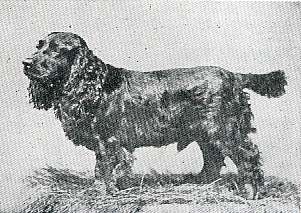 c. 1910  c. 1920  c. 1930  c. 1940  c. 1950  c. 1970 |
Spaniels have been around for a very long time, with Spanish records being made of a "Spaniell" as far back as 1386. There are many references in print and art to support their popularity as a bird dog with "a short round head when compared to that of a Springer, much smaller in size, more compact... his ears are usually long and well feathered, as are his legs and tail." (James Watson 1907) The name "Cocker Spaniel" arose not only from the breed's specific use for flushing woodcock fowl, but also in broader terms of the sport of "cock shooting", including all types of game birds. The first Cocker Spaniel was registered in the USA in 1879 and shortly thereafter, in 1881, The American Spaniel Club was founded, predating the formation of the Cocker Club in England by 4 years. In those early years, there was little clear definition of type, with styles ranging from Sussex-type Spaniels to Field-type Spaniels. With the AKC's regulation that a dog required a three-generation pedigree in order to be recorded in the Stud Book, a standard type began to evolve, and with it, the separation in type from the English Cocker Spaniel.
One prominent sire and top performer, Obo II, had an enormous influence on the new style - lower on the leg, longish body, moderate head and muzzle. Critiques were concerned that he was a "trifle full in the eye" - this characteristic has become the hallmark of the American Cocker, lending him a distinctive "soft and appealing" expression. In the 1930s a newer style evolved that attracted much attention in the show ring. Higher on the leg, this new style had a shorter muzzle and the body was more compact. Feathering was relatively sparse, confined mainly to the backs of the legs and under the belly. At this stage, the breed began to experience unprecedented popularity and managed to hold top spot in AKC registrations for nearly two decades. Along with demand, regrettably, came the puppy farmers - indiscriminate people eager to make a fast buck. The quality of conformation, health, and temperament of the American Cocker took a serious setback, and it took the combined efforts of dedicated breeders and veterinary researchers to address and control emerging health defects through the formation of an official registry. From the 1940s, the differences between the English and the American Cockers became so marked that the breeds were separated in 1947. At this time, heavier coats began to make their appearance, which called for considerable grooming and shaping to achieve a pleasing silhouette. The topline showed more slope and the little dog became even more compact. The face began to soften with a shorter, deeper muzzle and a more definite stop. By 1950, it was the immaculately-groomed, heavily-feathered dogs that were doing all the winning in the ring, so these dogs were bred to extensively. Between 1906 and 1943, the standard called for a coat that was "well-feathered". The 1957 standard included this alteration: "well-feathered, but not so excessively as to hide the Cocker Spaniel's true lines.... excessive coat and feathering shall be penalised." The statement seemed to have little, if any effect. The heavily-coated dogs won and continue to win today. Spanning a period of about 70 years, the American Cocker evolved through three major style changes. The breed has seen numerous changes to the Breed Standard, the latest AKC revision having been made in 1992. The smallest dog in the Gundog Group is possibly still in a stage of evolvement. Who knows where the fancy will take the breed type in 20 years time? Sources: |


